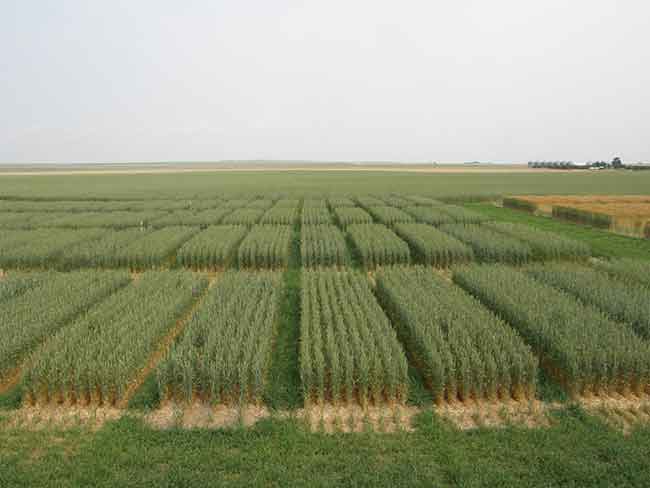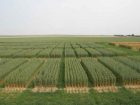
Features
Agronomy
Optimizing wheat grain protein
Canada Western Red Spring (CWRS) and Canada Western Amber Durum (CWAD) wheats have long been recognized as premium quality grains by the milling and pasta industries. Their quality is due primarily to the protein component of the grain.
October 3, 2016 By Ross H. McKenzie PhD P. Ag.
 Dryland spring wheat N trials at Bow Island Canada Western Red Spring (CWRS) and Canada Western Amber Durum (CWAD) wheats have long been recognized as premium quality grains by the milling and pasta industries. Their quality is due primarily to the protein component of the grain.
Dryland spring wheat N trials at Bow Island Canada Western Red Spring (CWRS) and Canada Western Amber Durum (CWAD) wheats have long been recognized as premium quality grains by the milling and pasta industries. Their quality is due primarily to the protein component of the grain.In the past, the Canadian Wheat Board was responsible for setting payment for wheat protein levels. Now, wheat protein premiums paid by grain buyers are in response to supply and demand. Many grain companies will pay premiums for wheat with protein levels greater than 14 per cent for CWRS and 13.5 per cent for CWAD. When there is a good supply of high protein wheat, the premiums paid decline. When there is an over abundant supply of high protein wheat, grain companies may not pay a premium. There are not that many grain buyers and the market for high-protein wheat is narrow.
Each year farmers should carefully review their plans as to what types of wheat they will grow for the various markets. Farmers planning to optimize wheat protein content should review their management each year to constantly fine-tune their practices. These include: selecting the best varieties for your region; crop rotation and agronomic practices; nitrogen (N) fertilizer management, and; management of other nutrients.
Environmental factors can play a significant role in influencing grain protein: timing and amount of growing season precipitation; temperature and heat (degree days) during the growing season, and; soil N reserve levels (mineralization of soil organic matter N throughout the growing season will add to available N).
Wheat protein
Nitrogen is a major component in wheat protein. When N supply increases, both yield and protein will increase. N taken up before heading generally increases yield as long as water, phosphorus, potassium and sulphur are not limiting. When yield reaches its maximum, additional N will continue to increase protein to a maximum level. But, when N is very deficient, grain protein content decreases with increasing yield due to a dilution effect. Much of the N taken up by wheat before heading or flowering is moved to the kernel during grain fill to increase grain protein. Wheat can still take up N during and after heading; this N tends to increase protein, but does not contribute to increased yield potential.
As mentioned, weather can strongly affect wheat protein content. Warmer, drier conditions in July and August will reduce yield potential but increase grain protein. Cooler, wetter growing conditions will increase yield potential but reduce grain protein content.
Genetic potential of wheat varieties
Wheat varieties differ in their genetics. Higher protein varieties tend to be lower yielding, and higher yielding varieties tend to have lower protein. Care should be taken when selecting varieties to consider both yield and protein potential as well as overall agronomic characteristics for the region you farm. Be sure to select the best regionally adapted variety for your area. Disease resistance is constantly breaking down in older varieties, but breeding advances are constantly improving disease resistance and agronomic characteristics. Each year, review new varieties available that may be well- suited for your region and suit your growing requirements.
Farmers should be aware that effective Aug. 1, 2018, 25 wheat varieties will no longer meet the revised quality parameters of CWRS, but will meet the quality parameters of the new Canada Northern Hard Red (CNHR) class. Make sure you understand the new wheat classes and how changes may affect you and the varieties you grow.
Crop rotation and seeding management
Wheat grown after a pulse crop (such as pea) will frequently have higher protein than wheat grown after another cereal crop. Ideally, wheat should not be grown on wheat stubble due to higher disease potential resulting in lower yield. Seed on the high end of the recommended range for your region. This will reduce the number of tillers, shorten time to maturity and produce more uniform crop quality. Higher seeding rates should also be used when seed size is larger, seeding is later or when soil moisture conditions are very good.
Most Prairie farmers grow wheat under reduced or no-till management rather than conventional tillage. This tends to increase available soil moisture and reduce the mineralization rate at which N becomes available. To compensate, an additional 20 to 30 pounds of N per acre (lb N/ac) is often required under no-till versus conventional till to achieve acceptable wheat yield and protein.
Nitrogen fertilizer management
The most important management factor to produce high wheat protein is providing adequate available N.
Each year, review your yield and protein results from previous years to evaluate the effectiveness of your N fertilization practices. Assess if your practices have been successful in achieving high protein. Remember: if spring wheat protein is under 13 per cent, yield and protein have likely been limited due to a lack of N fertilizer.
Soil testing to determine plant-available N is the starting point to decide on appropriate rates of N fertilizer application. Soil samples should be taken to 24 inches. Information provided by the soil analysis can be used in conjunction with N fertilizer cost, predicted grain yield and protein response to weigh the economic feasibility of N fertilizer application. Most labs provide a range of N fertilizer recommendations depending on your yield goal, but many won’t make N recommendations based on a protein goal.
Remember fertilizer management for high protein wheat is a huge challenge since it is not possible to predict growing season moisture and temperature. Higher rates of N applied at or before seeding to increase protein have a higher level of investment risk under dryland farming. If precipitation does not follow this optimistic management, investment in N fertilizer may not generate any additional income. But, if normal or higher than normal rainfall occurs and a crop is under fertilized, potential income is lost.
Grain protein content is affected by the timing of N fertilizer application. An adequate pre-plant application of N is essential to establish yield potential. However, N taken up by the plant after the boot stage (just before heading) will increase grain protein to a greater extent than it will increase yield. Therefore, the supply of N to the plant should be maintained through the boot stage to provide for optimum yield and protein potential.
Split-applying N, with significant N fertilization at seeding and additional mid-season application between tilling and the boot stage, is one strategy to manage protein. With this approach, the risk of applying a single, high rate of N early in the season is reduced. The decision to apply further N can be based on established crop yield potential and mid-season growing conditions. Western Canadian research has shown in-crop granular and foliar nitrogen applications at tillering, boot and anthesis growth stages do not consistently increase grain protein. Therefore, in-crop applications are less reliable than applying additional N fertilizer at or before seeding.
There are also risks associated with top-dressing N. Broadcast granular urea (46-0-0) fertilizer or dribble-banded liquid N (28-0-0) must be followed by rain to move the N into the root zone. A mid-season drought can strand the N at the soil surface until rain occurs. Another risk of this split application is the potential for N from urea (46-0-0) or liquid urea ammonium nitrate (UAN, 28-0-0) to volatilize and be lost to the atmosphere, especially under warm soil conditions common during this critical boot stage of the crop. An in-crop N application should be in the range of at least 30 to 40 lb N/ac to impact grain protein. Remember that in-crop N applications are often only about 40 per cent or less in efficiency of N uptake. Therefore, a 30 lb N/ac application taken up at 40 per cent efficiency means only 12 lb N/ac will be taken up by the plant.
Foliar application is recommended by some agronomists, but rates of more than 20 lb/ac of N as UAN can lead to leaf burn and crop injury, unless the liquid N is diluted with water. Research has shown less than five per cent of foliar-applied N actually enters the plant through leaf surfaces. To be effective, foliar N needs to be washed off leaves and moved into the soil with rainfall. Foliar fertilization to increase grain protein has limitations and risks.
Slow release N fertilizers such as ESN can provide a sustained supply of available N over about 60 days after application at seeding. Slow release N can be effective at providing N fertilizer to contribute to increased grain protein. This type of fertilizer can be applied in a blend with conventional fertilizers or on its own at seeding. The additional cost for these fertilizers must be considered relative to the potential benefits. In-crop broadcast application of ESN during the growing season is not recommended as the release rate is too slow to be effective to increase grain protein.
Past cropping practices and land management can affect N availability over the growing season. Livestock manure may release N for two or more years after application as the organic matter in the manure is released. Annual or perennial legume crop residues will also increase soil N supplies later in the growing season. N released from these practices can increase the protein content of wheat.
Other fertilizers
It is important that other nutrients are applied, as necessary, to ensure optimum wheat growth and yield. Soil testing is important to assist with this. Remember that about 80 per cent of Prairie soils are phosphorus (P) deficient and about 30 per cent are potassium (K) deficient. Deficiencies of sulphur (S) are increasingly common, particularly in the thin black, black, and gray soil zones. Sulphur fertilizer will increase protein content when soil S levels are low.
